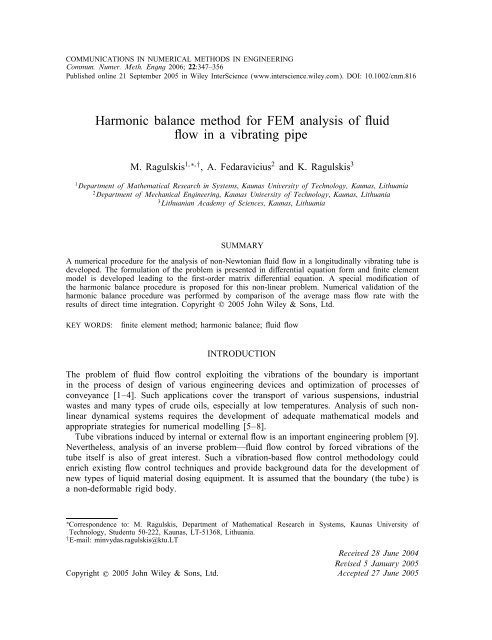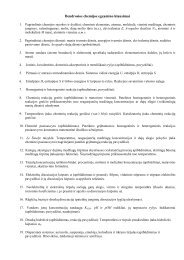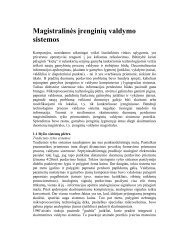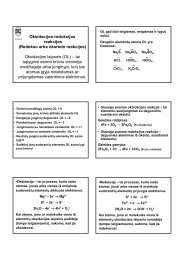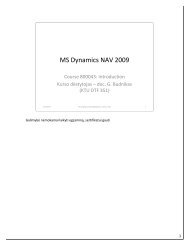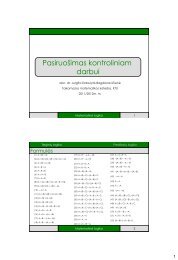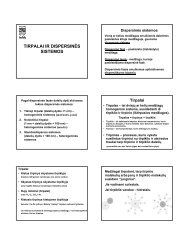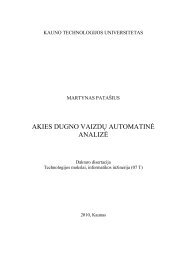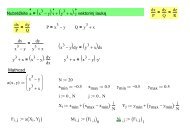Harmonic balance method for FEM analysis of fluid flow in a ...
Harmonic balance method for FEM analysis of fluid flow in a ...
Harmonic balance method for FEM analysis of fluid flow in a ...
Create successful ePaper yourself
Turn your PDF publications into a flip-book with our unique Google optimized e-Paper software.
COMMUNICATIONS IN NUMERICAL METHODS IN ENGINEERINGCommun. Numer. Meth. Engng 2006; 22:347–356Published onl<strong>in</strong>e 21 September 2005 <strong>in</strong> Wiley InterScience (www.<strong>in</strong>terscience.wiley.com). DOI: 10.1002/cnm.816<strong>Harmonic</strong> <strong>balance</strong> <strong>method</strong> <strong>for</strong> <strong>FEM</strong> <strong>analysis</strong> <strong>of</strong> uidow <strong>in</strong> a vibrat<strong>in</strong>g pipeM. Ragulskis 1; ∗; † , A. Fedaravicius 2 and K. Ragulskis 31 Department <strong>of</strong> Mathematical Research <strong>in</strong> Systems; Kaunas University <strong>of</strong> Technology, Kaunas; Lithuania2 Department <strong>of</strong> Mechanical Eng<strong>in</strong>eer<strong>in</strong>g; Kaunas University <strong>of</strong> Technology; Kaunas; Lithuania3 Lithuanian Academy <strong>of</strong> Sciences; Kaunas; LithuaniaSUMMARYA numerical procedure <strong>for</strong> the <strong>analysis</strong> <strong>of</strong> non-Newtonian uid ow <strong>in</strong> a longitud<strong>in</strong>ally vibrat<strong>in</strong>g tube isdeveloped. The <strong>for</strong>mulation <strong>of</strong> the problem is presented <strong>in</strong> dierential equation <strong>for</strong>m and nite elementmodel is developed lead<strong>in</strong>g to the rst-order matrix dierential equation. A special modication <strong>of</strong>the harmonic <strong>balance</strong> procedure is proposed <strong>for</strong> this non-l<strong>in</strong>ear problem. Numerical validation <strong>of</strong> theharmonic <strong>balance</strong> procedure was per<strong>for</strong>med by comparison <strong>of</strong> the average mass ow rate with theresults <strong>of</strong> direct time <strong>in</strong>tegration. Copyright ? 2005 John Wiley & Sons, Ltd.KEY WORDS:nite element <strong>method</strong>; harmonic <strong>balance</strong>; uid owINTRODUCTIONThe problem <strong>of</strong> uid ow control exploit<strong>in</strong>g the vibrations <strong>of</strong> the boundary is important<strong>in</strong> the process <strong>of</strong> design <strong>of</strong> various eng<strong>in</strong>eer<strong>in</strong>g devices and optimization <strong>of</strong> processes <strong>of</strong>conveyance [1–4]. Such applications cover the transport <strong>of</strong> various suspensions, <strong>in</strong>dustrialwastes and many types <strong>of</strong> crude oils, especially at low temperatures. Analysis <strong>of</strong> such nonl<strong>in</strong>eardynamical systems requires the development <strong>of</strong> adequate mathematical models andappropriate strategies <strong>for</strong> numerical modell<strong>in</strong>g [5–8].Tube vibrations <strong>in</strong>duced by <strong>in</strong>ternal or external ow is an important eng<strong>in</strong>eer<strong>in</strong>g problem [9].Nevertheless, <strong>analysis</strong> <strong>of</strong> an <strong>in</strong>verse problem—uid ow control by <strong>for</strong>ced vibrations <strong>of</strong> thetube itself is also <strong>of</strong> great <strong>in</strong>terest. Such a vibration-based ow control <strong>method</strong>ology couldenrich exist<strong>in</strong>g ow control techniques and provide background data <strong>for</strong> the development <strong>of</strong>new types <strong>of</strong> liquid material dos<strong>in</strong>g equipment. It is assumed that the boundary (the tube) isa non-de<strong>for</strong>mable rigid body.∗ Correspondence to: M. Ragulskis, Department <strong>of</strong> Mathematical Research <strong>in</strong> Systems, Kaunas University <strong>of</strong>Technology, Studentu 50-222, Kaunas, LT-51368, Lithuania.† E-mail: m<strong>in</strong>vydas.ragulskis@ktu.LTReceived 28 June 2004Revised 5 January 2005Copyright ? 2005 John Wiley & Sons, Ltd. Accepted 27 June 2005
348 M. RAGULSKIS, A. FEDARAVICIUS AND K. RAGULSKISThe nite element <strong>for</strong>mulation is used together with the approximate procedure <strong>for</strong> the<strong>analysis</strong> <strong>of</strong> non-l<strong>in</strong>ear steady-state vibrations which consists from two basic steps. First anite element model is developed lead<strong>in</strong>g to the rst-order matrix dierential equation. Thenan approximate steady-state solution is sought us<strong>in</strong>g the proposed harmonic <strong>balance</strong> procedurewhich consists from the follow<strong>in</strong>g ma<strong>in</strong> steps:(1) problem <strong>for</strong>mulation <strong>in</strong> dierential equation <strong>for</strong>m;(2) development <strong>of</strong> the nite element problem <strong>for</strong>mulation;(3) modal decomposition <strong>of</strong> the solution;(4) development and application <strong>of</strong> the harmonic <strong>balance</strong> <strong>method</strong>.The harmonic <strong>balance</strong> <strong>method</strong> <strong>in</strong> general is one <strong>of</strong> the most straight<strong>for</strong>ward and practical<strong>method</strong>s <strong>for</strong> estimat<strong>in</strong>g periodic steady-state solutions and can be applied to non-l<strong>in</strong>ear equationswith a periodic <strong>for</strong>c<strong>in</strong>g term, thus provid<strong>in</strong>g better understand<strong>in</strong>g <strong>of</strong> the reasons <strong>for</strong> thenon-l<strong>in</strong>ear eects tak<strong>in</strong>g place <strong>in</strong> the system [10].A semi-analytical <strong>method</strong> <strong>for</strong> calculat<strong>in</strong>g a non-Newtonian uid ow <strong>in</strong> a vibrat<strong>in</strong>g pipe ispresented. The <strong>method</strong> uses an ecient harmonic <strong>balance</strong> approach to evaluate steady-stateuid ow elim<strong>in</strong>at<strong>in</strong>g the time <strong>in</strong>tegration.FINITE ELEMENT MODELA Cartesian coord<strong>in</strong>ate system is dened where the z-axis is parallel to the axis <strong>of</strong> the tube(Figure 1). It is assumed that the cross-section <strong>of</strong> the tube does not vary with the z coord<strong>in</strong>ateand the velocity <strong>of</strong> uid ow does not depend on z, i.e. w = w(x; y; t), where w denotes thevelocity and t the time. The other components <strong>of</strong> velocity are assumed to be equal to zero.Thus the condition <strong>of</strong> <strong>in</strong>compressibility is satised identically. The stresses take the <strong>for</strong>m x = y = z = −p; xy =0; yz = @w@y ;where p denotes the pressure and the viscosity <strong>of</strong> the uid. zx = @w@x(1)Figure 1. The pr<strong>in</strong>cipal model <strong>of</strong> the system.Copyright ? 2005 John Wiley & Sons, Ltd. Commun. Numer. Meth. Engng 2006; 22:347–356
HARMONIC BALANCE METHOD FOR FLUID FLOW 349The dynamic equilibrium equation <strong>in</strong> the direction <strong>of</strong> the z-axis can be written as(@ @w )+ @ ( @w )− @p + g = @w(2)@x @x @y @y @z @twhere is the density <strong>of</strong> the uid, g is the acceleration <strong>of</strong> gravity, and @p=@z the gradient<strong>of</strong> the pressure <strong>in</strong> the direction <strong>of</strong> the z-axis, is assumed constant along the tube. It is alsoassumed that the uid is non-Newtonian and that the viscosity is expressed as√ (@w ) 2 = 1 + 2 +@x( ) 2 @w(3)@ywhere 1 and 2 are constants. The non-Newtonian model given by Equation (3) presentsan approximation <strong>for</strong> the pseudoplastic model <strong>of</strong>ten used <strong>for</strong> the description <strong>of</strong> the non-l<strong>in</strong>earfeatures <strong>of</strong> suspensions [11].The wall boundary condition− @w@n = (w − w∗ ) (4)takes <strong>in</strong>to account the longitud<strong>in</strong>al vibration <strong>of</strong> the tube, where n is the outward normaldirection to the boundary <strong>of</strong> the cross-section <strong>of</strong> the ow <strong>in</strong>side the tube, is the coecient<strong>of</strong> slippage (slid<strong>in</strong>g friction between the uid and the surface <strong>of</strong> the tube) and w ∗ is thevelocity <strong>of</strong> the wall <strong>in</strong> the direction <strong>of</strong> the z-axis. It is assumed that the boundary per<strong>for</strong>msharmonic oscillations <strong>in</strong> the direction <strong>of</strong> the z-axis, so thatw ∗ = a s<strong>in</strong> !t (5)where a and ! denote the amplitude and the frequency <strong>of</strong> oscillations. The amplitude <strong>of</strong>k<strong>in</strong>ematic excitation <strong>of</strong> the boundary is a=!.It can be noted that, <strong>for</strong> the pipe <strong>of</strong> circular cross-section, the problem is axi-symmetricbut, bear<strong>in</strong>g <strong>in</strong> m<strong>in</strong>d that the results are applicable also <strong>for</strong> other tube shapes (to the tubes<strong>of</strong> other cross-sections), the 2D problem is solved. The cross-section <strong>of</strong> the ow is meshedus<strong>in</strong>g the nite element approximation. The result<strong>in</strong>g matrix dierential equation:[C]{ ˙} +[K]{} = {F} (6)is obta<strong>in</strong>ed on the basis <strong>of</strong> the Galerk<strong>in</strong> <strong>method</strong> <strong>of</strong> weighted residuals [11, 12]. <strong>FEM</strong> matricestake the <strong>for</strong>m:∫∫[C]= [N ] T [N ]dx dy∫∫[K]=∮[B] T 1 [B]dx dy + [M] T [M]ds∫∫ ({F}= [N] T∮+ [M] T w ∗ dsg − @p@z) ∫∫dx dy −√ (@w ) 2[B] T 2 +@x( ) 2 @w[B]{} dx dy@y(7)Copyright ? 2005 John Wiley & Sons, Ltd. Commun. Numer. Meth. Engng 2006; 22:347–356
350 M. RAGULSKIS, A. FEDARAVICIUS AND K. RAGULSKISwhere {} is the vector <strong>of</strong> nodal velocities. The upper dot <strong>in</strong> Equation (6) denotes dierentiationwith respect to time; s is the boundary l<strong>in</strong>e <strong>of</strong> the cross-section <strong>of</strong> the ow;[N]=[N 1 N 2 ··· N n ]⎡@N 1 @N 2···@x @x[B]=⎢⎣@N 1 @N 2···@y @y[M]=[M 1 M 2 ··· M m ]@N n@x@N n@y⎤⎥⎦(8)where N 1 ;N 2 ::: are the shape functions <strong>of</strong> the nite element <strong>in</strong> the cross-section <strong>of</strong> the ow,M 1 ;M 2 ::: are the shape functions <strong>of</strong> the nite element on the boundary <strong>of</strong> the cross-section<strong>of</strong> the ow.The nite element equations could be <strong>in</strong>tegrated <strong>in</strong> time and transient ow processes canbe analysed. Instead approximate <strong>method</strong>s <strong>of</strong> non-l<strong>in</strong>ear vibration theory are applied to thisproblem.HARMONIC BALANCE PROCEDUREFirst the eigenpairs <strong>of</strong> the homogeneous system [C]{ ˙}+[K]{} = 0 are determ<strong>in</strong>ed and modaldecomposition <strong>of</strong> Equation (6) is per<strong>for</strong>med [12]:[] T [C][]{Ż} + [] T [K][]{Z} = [] T {F} (9)where [] = [{ 1 } { 2 } :::];{ i } is the ith exponential decay eigenmode with correspond<strong>in</strong>geigenvalue i . Then the vector <strong>of</strong> velocities is expressed as⎧ ⎫z 1 ⎪⎨ ⎪⎬{} = []{Z} = [] z 2⎪⎩ ⎪⎭···where z i denote modal coecients <strong>for</strong> mode i.The determ<strong>in</strong>ation <strong>of</strong> the averaged surface <strong>of</strong> velocities is per<strong>for</strong>med by solv<strong>in</strong>g the follow<strong>in</strong>gfour successive problems.A. Steady-state harmonic solution. The s<strong>in</strong>usoidal variation <strong>of</strong> the wall velocity is assumedwhile the condition −(@p=@z)+g = 0 is be<strong>in</strong>g satised, and the steady-state harmonic motion<strong>of</strong> the l<strong>in</strong>ear system is obta<strong>in</strong>ed by solv<strong>in</strong>g the modal equations:(10)ddt (z i)+ i z i = f i (11)Copyright ? 2005 John Wiley & Sons, Ltd. Commun. Numer. Meth. Engng 2006; 22:347–356
HARMONIC BALANCE METHOD FOR FLUID FLOW 351where f i is the modal ⎧load<strong>in</strong>g ⎫ <strong>for</strong> mode i. It is assumed that {F} = {F s } s<strong>in</strong> !t. Then,{F s } = ∮ ⎪⎨ f[M] T 1s ⎪⎬a ds and f2⎪⎩s ···⎪⎭ = []T {F s }. Thus f i = fis s<strong>in</strong> !t, produc<strong>in</strong>gz i = zi s s<strong>in</strong> !t + zi c cos !t (12)The vectors <strong>of</strong> the s<strong>in</strong>e and cos<strong>in</strong>e components <strong>of</strong> the steady-state motion { s } and { c } arethen expressed like:⎧ ⎫⎧ ⎫z1⎪⎨s z1⎪⎬⎪⎨c ⎪⎬{ s } = [] z2s ; { c } = [] z2c (13)⎪⎩ ⎪⎭⎪⎩ ⎪⎭······The follow<strong>in</strong>g system <strong>of</strong> l<strong>in</strong>ear algebraic equations is solved <strong>for</strong> each eigenmode:[ ]{ } { }i −! zsi fsi=! i zic 0(14)B. Static solution. The static (constant <strong>in</strong> time) solution is obta<strong>in</strong>ed assum<strong>in</strong>g that the term−(@p=@z)+g is constant <strong>in</strong> time and the wall velocity is equal to zero, that is:∫∫ ({F 0 } = [N] T g − @p )dx dy (15)@zThis requires the solution <strong>of</strong> the system <strong>of</strong> l<strong>in</strong>ear algebraic equations:[K]{ 0 } = {F 0 } (16)⎧ ⎫⎪⎨ f10 ⎪⎬This solution aga<strong>in</strong> is sought us<strong>in</strong>g modal decomposition. Denot<strong>in</strong>g f2⎪⎩0⎪⎭ = []T {F 0 } and⎧ ⎫···⎪⎨ z10 ⎪⎬{ 0 } = [] z2⎪⎩0 , <strong>for</strong> each eigenmode we have:⎪⎭···zi 0 = f0 i(17) iUp to this po<strong>in</strong>t the Newtonian model <strong>of</strong> the uid is used as an approximation. The totalvelocities are:{(t)} = { 0 } + { s } s<strong>in</strong> !t + { c } cos !t (18)C. Averaged transverse velocities. The load vector is obta<strong>in</strong>ed <strong>in</strong> the process <strong>of</strong> assembly <strong>of</strong>the follow<strong>in</strong>g loads:(a) the load occurr<strong>in</strong>g from the constant term −(@p=@z)+g;(b) the non-l<strong>in</strong>ear term due to the static solution and the harmonic motion.Copyright ? 2005 John Wiley & Sons, Ltd. Commun. Numer. Meth. Engng 2006; 22:347–356
352 M. RAGULSKIS, A. FEDARAVICIUS AND K. RAGULSKISThose calculations are per<strong>for</strong>med <strong>for</strong> a number <strong>of</strong> discrete moments equally spaced dur<strong>in</strong>gthe period. Time average <strong>of</strong> load vector takes the <strong>for</strong>m:√∫∫ ({F 1 } = [N] T g − @p ) ∫∫ (@w ) 2dx dy − [B]@zT 2 +@x⎛ √∫∫ (= [N] T g − @p )dx dy − 1 ∫∫ √√√ (m∑ ⎜@w⎝ [B] T 2@z m i=1@x( ) 2m (i − 1){× [B] { 0 } + { s } s<strong>in</strong>( ) 2 @w[B]{} dx dy@y) 2 ( ) 2@w∣ +t=ti@y ∣t=ti⎞( )}2+ { c } cosm (i − 1) dx dy⎠ (19)where the upper dash denotes time average; !t =(2=m)(i − 1);⎧@w⎪⎨ @x ∣⎫⎪t=ti⎬ {( ) ( )}2 2 =[B] {@w0 } + { s } s<strong>in</strong>m (i − 1) + { c } cosm (i − 1) ⎪⎩⎪@y ∣ ⎭t=ti(20)m is the number <strong>of</strong> discrete time moments <strong>in</strong> a period.F<strong>in</strong>ally, the non-l<strong>in</strong>ear problem is solved obta<strong>in</strong><strong>in</strong>g the averaged surface <strong>of</strong> velocities us<strong>in</strong>gpreviously described technique <strong>of</strong> modal decomposition <strong>for</strong> the solution <strong>of</strong> the system <strong>of</strong> l<strong>in</strong>earalgebraic equations:[K]{ 1 } = {F 1 } (21)D. Mass ow rate. F<strong>in</strong>ally, the average mass ow rate is found by <strong>in</strong>tegrat<strong>in</strong>g over thecross-sectional area:∫∫Q = w(x; y)dx dy (22)where w(x; y) are the averaged transverse velocities which are calculated from { 1 } by us<strong>in</strong>gthe shape functions <strong>of</strong> the appropriate nite elements. It is assumed that the averag<strong>in</strong>g <strong>in</strong>tervalis much longer than the period <strong>of</strong> oscillations.NUMERICAL RESULTSCross-section <strong>of</strong> the tube is assumed to be a circle and one-fourth <strong>of</strong> it is analysed (Figure 2).The characteristics <strong>of</strong> the non-Newtonian uid represent a liquid-type suspension ( 1 =0:004g=mm s = 4 cP, 2 = − 0:0001 g=mm, =0:04 g=mm 2 s, =0:001 g=mm 3 , −(@p=@z) +g =0:003 g=mm 2 s 2 ). Radius <strong>of</strong> the tube is R = 10 mm; number <strong>of</strong> moments <strong>in</strong> the period used <strong>for</strong>Copyright ? 2005 John Wiley & Sons, Ltd. Commun. Numer. Meth. Engng 2006; 22:347–356
354 M. RAGULSKIS, A. FEDARAVICIUS AND K. RAGULSKISFigure 3. Numerical validation <strong>of</strong> the harmonic <strong>balance</strong> procedure.Figure 4. Relationship between the mass ow rate Q(g=s) and the amplitude <strong>of</strong> excitation a=! (mm) atvarious frequencies <strong>of</strong> excitation ! i =(i − 1) · 0; 2; i =1;:::;21.the cost <strong>of</strong> numerical <strong>in</strong>tegration over one time step is W; the calculation <strong>of</strong> the mass owrate is per<strong>for</strong>med <strong>for</strong> each time step at a cost w; m time steps <strong>in</strong> a period <strong>of</strong> excitation areused; 10 periods are required to achieve steady-state motion, the cost <strong>of</strong> numerical <strong>in</strong>tegrationcan be approximated as 10m(W + w).Copyright ? 2005 John Wiley & Sons, Ltd. Commun. Numer. Meth. Engng 2006; 22:347–356
HARMONIC BALANCE METHOD FOR FLUID FLOW 355The costs <strong>of</strong> the stages <strong>of</strong> the harmonic <strong>balance</strong> procedure <strong>for</strong> the same problem can beapproximated:A. Steady-state harmonic solution—cost is W (comparable with one time step <strong>for</strong> the samemesh<strong>in</strong>g).B. Static solution—cost is W=2 (about 50% <strong>of</strong> the cost <strong>of</strong> harmonic solution).C. Determ<strong>in</strong>ation <strong>of</strong> the averaged transverse velocities—cost is mW=2 (m is the number <strong>of</strong>discrete time moments <strong>in</strong> a period <strong>of</strong> excitation);D. Determ<strong>in</strong>ation <strong>of</strong> the average mass ow rate—cost is w.Thus the total cost <strong>of</strong> the proposed harmonic <strong>balance</strong> procedure is ((3 + m)=2) · W + w. Forrealistic mesh<strong>in</strong>gs w can be approximated as 0:1 W . So the cost <strong>of</strong> the proposed harmonic<strong>balance</strong> procedure is about twenty times lower than that <strong>of</strong> numerical time <strong>in</strong>tegration. Numericalexperiments <strong>in</strong>dicate that the proposed harmonic <strong>balance</strong> procedure produces resultswhich <strong>in</strong> some cases can dier by about 10% from the ‘exact’ ones obta<strong>in</strong>ed from numerical<strong>in</strong>tegration.The problem <strong>for</strong> which the harmonic <strong>balance</strong> procedure was developed is typical <strong>for</strong> thetransportation <strong>of</strong> uid and there<strong>for</strong>e should be regarded as a demonstrational problem <strong>for</strong>develop<strong>in</strong>g the algorithm. The potential <strong>of</strong> the <strong>method</strong> lies <strong>in</strong> its possible applications to thethree dimensional non-l<strong>in</strong>ear problems <strong>of</strong> computational uid dynamics.CONCLUSIONSNumerical model describ<strong>in</strong>g ow <strong>of</strong> non-Newtonian uid <strong>in</strong> a tube per<strong>for</strong>m<strong>in</strong>g longitud<strong>in</strong>alvibrations is developed. It must be noted that this model <strong>in</strong>corporates non-l<strong>in</strong>earity and representsthe dynamic behaviour <strong>of</strong> the liquid suspension. The <strong>in</strong>ertia <strong>of</strong> the uid is taken <strong>in</strong>toaccount and <strong>FEM</strong> damp<strong>in</strong>g matrix is obta<strong>in</strong>ed. The velocity <strong>of</strong> the longitud<strong>in</strong>al motion <strong>of</strong>the walls is taken <strong>in</strong>to account through the boundary condition and thus is directly <strong>in</strong>corporated<strong>in</strong>to the nite element <strong>for</strong>mulation. <strong>Harmonic</strong> <strong>balance</strong> <strong>method</strong> <strong>for</strong> determ<strong>in</strong>ation <strong>of</strong>averaged transverse velocities <strong>of</strong> non-Newtonian uid is proposed. The results <strong>of</strong> the <strong>analysis</strong>show that the longitud<strong>in</strong>al tube vibrations can be eectively applied <strong>for</strong> uid ow control and<strong>in</strong>corporated <strong>in</strong>to the design <strong>of</strong> vibration spray<strong>in</strong>g and dos<strong>in</strong>g devices <strong>of</strong> various substances.REFERENCES1. Hui L, Tomita Y. A numerical simulation <strong>of</strong> swirl<strong>in</strong>g ow pneumatic convey<strong>in</strong>g <strong>in</strong> a horizontal pipel<strong>in</strong>e.Particulate Science and Technology: An International Journal 2000; 18(4):275–292.2. Hauser G, Sommer K. Plug ow type pneumatic convey<strong>in</strong>g <strong>of</strong> abrasive products <strong>in</strong> food <strong>in</strong>dustry. Journal <strong>of</strong>Powder and Bulk Solids Technology 1998; 12:511–519.3. Bubulis A, Ragulskis L. Dry substances transportation and dos<strong>in</strong>g us<strong>in</strong>g vibrations. 41 InternationalesWissenchaftliches Kolloquium, Ilmenau, 1996; 492–496.4. Ragulskis M, Palevicius A. Theoretical and experimental studies <strong>of</strong> tubular valve dynamics. InternationalJournal <strong>of</strong> Acoustics and Vibration 2002; 7(1):53–57.5. Morgan K, Peraire J. Unstructured grid nite element <strong>method</strong>s <strong>for</strong> uid dynamics. Reports on Progress <strong>in</strong>Physics 1998; 61(6):569–638.6. Thomasset F. Implementation <strong>of</strong> F<strong>in</strong>ite Element Methods <strong>for</strong> Navier–Stokes Equations. Spr<strong>in</strong>ger: Germany,1981; 159.7. Blawzdziewicz J, Feuillebois F. Calculation <strong>of</strong> an eective slip <strong>in</strong> a settl<strong>in</strong>g suspension at a vertical wall.International Journal <strong>of</strong> Fluid Mechanics Research 1995; 22(1):164–169.8. Baker AJ. F<strong>in</strong>ite Element Computational Fluid Mechanics. Hemisphere PC: U.S.A., 1983; 510.Copyright ? 2005 John Wiley & Sons, Ltd. Commun. Numer. Meth. Engng 2006; 22:347–356
356 M. RAGULSKIS, A. FEDARAVICIUS AND K. RAGULSKIS9. Huang Y, Hsu C. Dynamic behaviour <strong>of</strong> tubes subjected to <strong>in</strong>ternal and external cross ows. Journal <strong>of</strong> Shockand Vibration 1997; 4(2):77–91.10. Jordan DW, Smith P. Nonl<strong>in</strong>ear Ord<strong>in</strong>ary Dierential Equations. Ox<strong>for</strong>d University Press: U.K., 1999; 550.11. Rao SS. The F<strong>in</strong>ite Element Method <strong>in</strong> Eng<strong>in</strong>eer<strong>in</strong>g. Pergamon Press: U.K., 1982; 625.12. Zienkiewicz OC, Morgan K. F<strong>in</strong>ite Elements and Approximation. Mir: Moscow, 1986; 320.13. Hearn D, Baker MP. Computer Graphics. Prentice-Hall International: U.S.A., 1986; 351.Copyright ? 2005 John Wiley & Sons, Ltd. Commun. Numer. Meth. Engng 2006; 22:347–356


